
Vietnam’s lush and diverse vegetation is a result of the country’s tropical monsoon climate, sunny skies, and precipitation. Due to the location of the Vietnamese territory at the meeting point of atmospheric currents and the large number of seeds that have been transported there from the north, west, and south, there are several strains and species of flora in the forests. More than 800 different types of wood can be found in Vietnam. Many of these are prized for their strength, beauty, and exquisite textures and hues. Among the well-known wood species are ironwood, oak, teak, and others. Today we’re going to be diving into some of the most gorgeous and interesting trees native to Vietnam, starting with the flame tree!
1. Flame Tree
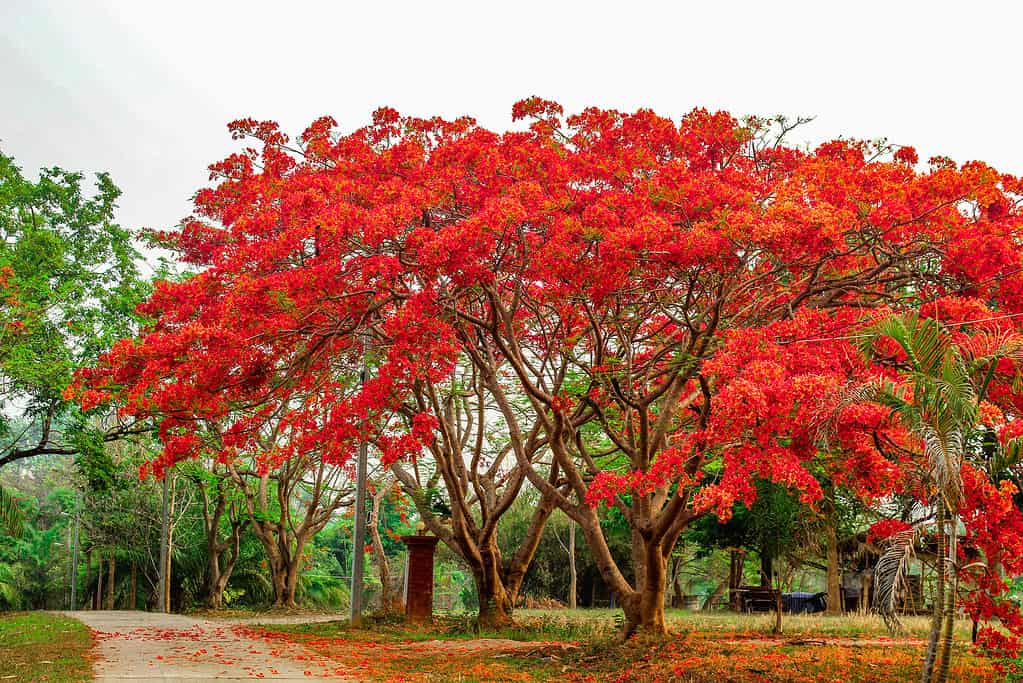
Flame trees have many names, including flamboyant trees and royal poinciana trees.
©Randall W Simpson/Shutterstock.com
This tree is a member of the bean family of flowering plants. It boasts colorful blooms in shades of red and orange and fern-like foliage. The petals measure around four inches in length. A fifth, upright petal that is typically larger than the other four petals can be observed in the center.
The tree itself can reach a height of 42 feet and has wide-spreading branches, making it fairly shaded. The smooth, but frequently slightly fractured, trunk of the red flamboyant tree. The trunk can be up to 6 1/2 feet around. The long, fluffy leaves can reach lengths of five to 10 inches.
2. Jackfruit Tree
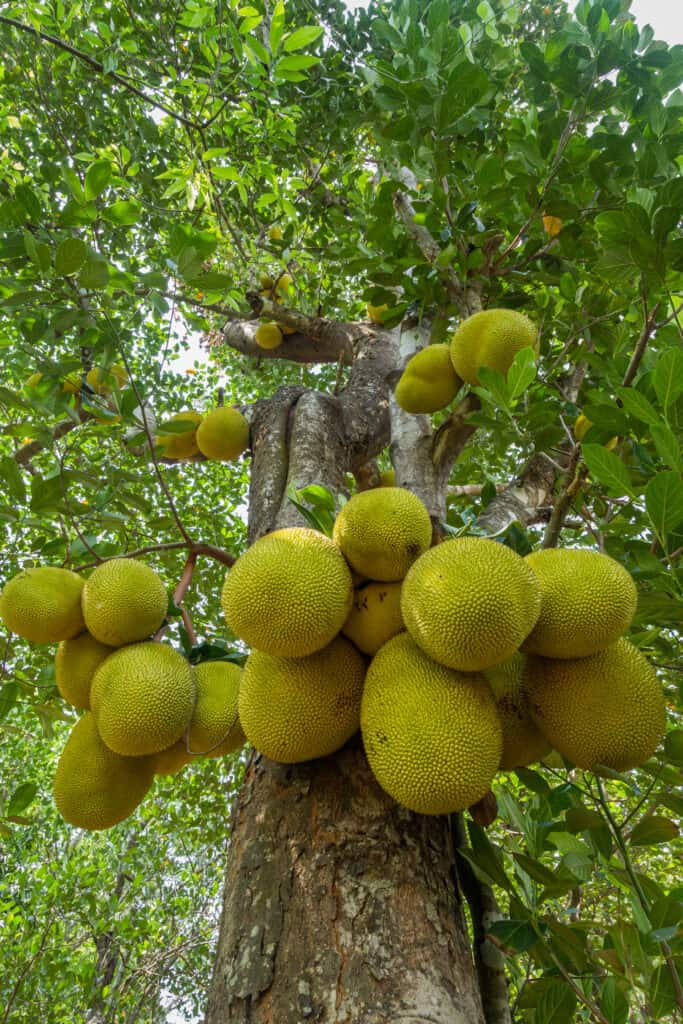
Each jackfruit tree produces around 200 jackfruits annually.
©v/Shutterstock.com
The jackfruit is both Sri Lanka’s and Bangladesh’s national fruit. It is also the national fruit of a number of tropical Asian nations. There, mature trees can reach heights of 66 feet. The ripe fruits are enormous, and the heaviest jackfruit ever recorded weighed almost 100 pounds!
Each tree produces roughly 200 fruits annually, with the typical fruit weighing around 33 pounds. For this precise reason, jackfruit trees are grown. The wonderful fruit’s pulp can be consumed raw, prepared, or cooked into food. It makes sense that using jackfruit as a meat replacement has become popular in North America given how ubiquitous the tree is.
Jackfruit trees are tropical evergreens with short tree trunks. Their trunks range in diameter from 12 to 31 inches with a dense canopy. The jackfruit tree has red bark and can reach heights of 33 to 66 feet. The thick, lustrous, and six to eight inches long jackfruit leaves are a deep green color. On the same tree, both male and female flowers can be found.
3. Copperpod Tree
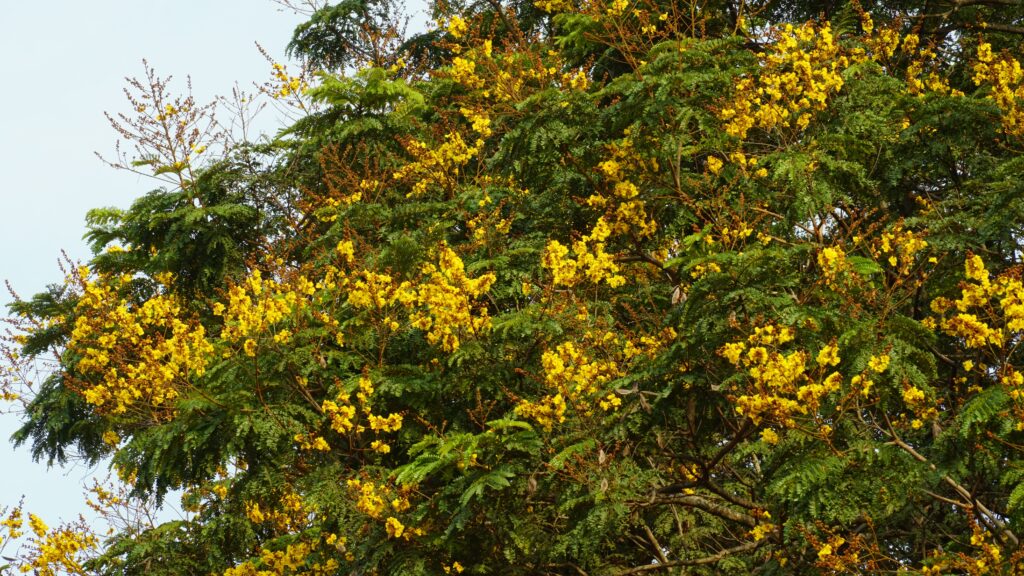
Many consider the copperpod tree to be particularly invasive.
©rakesh kp/Shutterstock.com
This tree grows quickly and thrives in full sun on very well-drained soil. The leaves fall when the temperature is in the high 20s, but they are rapidly restored. In four to five years, young trees begin to bloom.
The copperpod tree is known to be invasive and will easily grow on roadsides and other unsuspecting places. This tree’s pronounced stipules — located near the base of the petioles — distinguish it from mimosa and jacaranda.
These trees frequently develop multiple erect stems and crotches covered in bark. Further, these can weaken and break the tree in two. To reduce included bark growth and any harm from falling branches, carefully follow the trimming instructions. Copperpod trees have a weak ability to compartmentalize rot. This causes decay in older trees, particularly those that have had inappropriate pruning.
4. Teak Tree

Only as they age do teak trees gain green foliage, which is initially red.
©iStock.com/naumax
Teak trees are striking, tall mint family members. When the leaves initially sprout, the tree’s foliage is red; but, as they age, it turns green. Teak wood is noted for its strength and beauty and is produced by teak trees.
Hardwood trees called teaks can be found in the monsoon rainforests of southern Asia, particularly in India, Myanmar, Thailand, and Vietnam. Unfortunately, overlogging has resulted in the disappearance of many natural teak forests.
Teak trees can live for a century and reach heights of 150 feet. The leaves on these trees have a rough texture and are a reddish-green color. Teak trees lose their leaves during the dry season, and then when it rains, they grow them back.
5. Coconut Palm
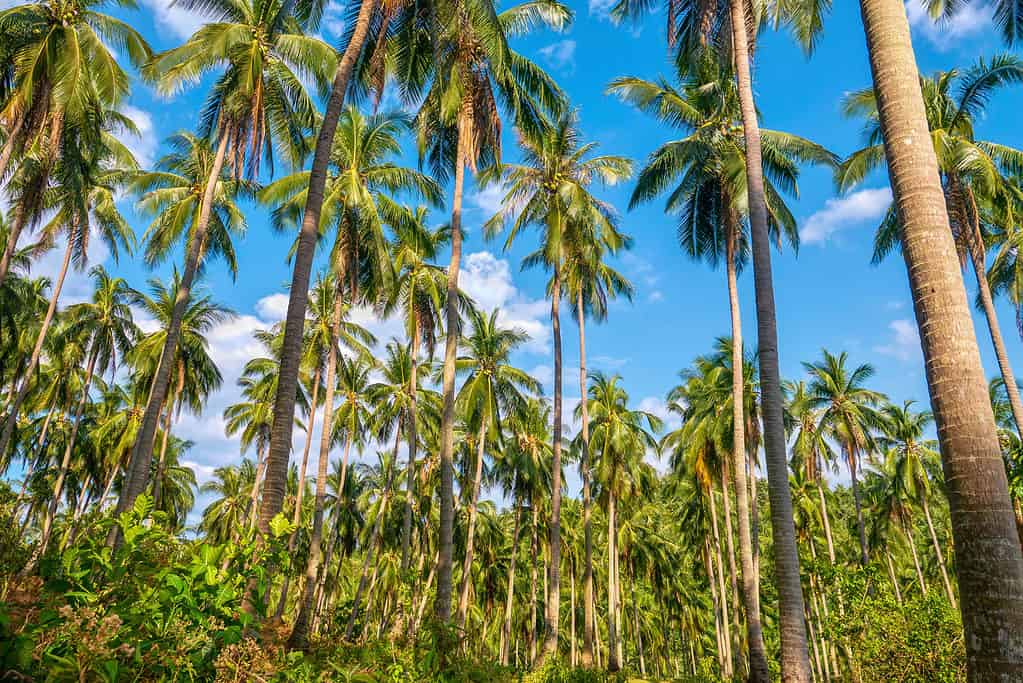
You can find coconut palm trees on almost all tropical coasts.
©iStock.com/Cheryl Ramalho
Almost everywhere along tropical coasts, coconut palms can be found. They likely originated in Indo-Malaya. These are the most economically significant species of palm tree, with coconuts being one of the main tropical crops.
The coconut palm has an elegant crown of enormous leaves that resemble feathers and a leaning trunk that can reach a height of up to 80 feet from a swelling base. Mature fruits feature a thick fibrous husk covering the well-known single-seeded nut of trade, which are ovoid or ellipsoid in shape, 12–18 inches long, and six to eight inches in diameter. The tiny embryo’s copious endosperm, which is made up of both liquid and meat, is enclosed in a hard shell.
6. Tropical Almond
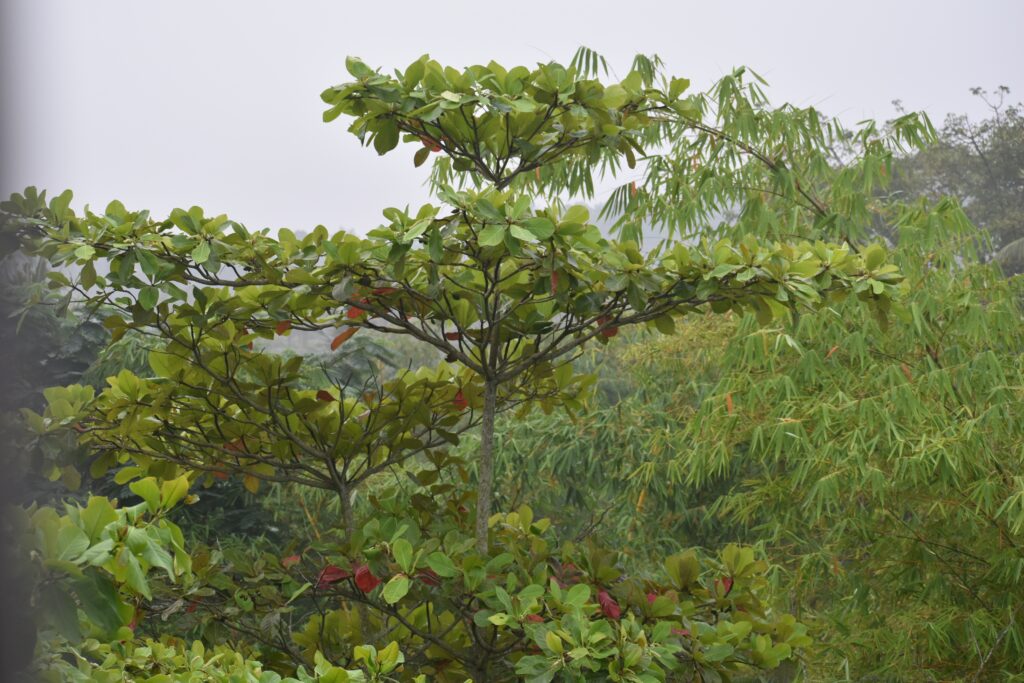
The tops of tropical almond trees flatten as they age.
©Suresh K Srivastava/Shutterstock.com
The deciduous, 30-to-55-foot-tall tropical almond tree has horizontal branches that can grow as wide as 50 feet at maturity and has a symmetrical, upright shape in its youth. The tree’s evident tiers of branches give it a pagoda-like appearance.
Tropical almond trees have a crown that develops into a wide-spreading pitcher shape as it gets older and flattens out toward the top. The enormous, glossy, dark-green, leathery leaves measure 15 inches long by six inches wide, and they turn stunning colors of red, yellow, and violet before falling in the winter.
These enormous old leaves can be viewed as a problem by some due to their size. The tree is barren for only a brief time before the leaves are immediately replaced by new growth.
7. Indian Milkwood Pine

Milkwood pine trees are prized for their appearance and use.
©aimpol buranet/Shutterstock.com
In October, this tall, graceful tree produces many clusters of little, fragrant green blooms. The tree has a lovely shape because of the regular branching and the somewhat rounded, velvety, dark green leaves that form appealing whorls.
A native of the Indian subcontinent, Malaysia, and Australasia, the evergreen tropical tree’s bark, also known as “Dita Bark,” is employed in traditional medical treatments to treat a number of ailments.
This very unusual plant is prized as a quick-growing, outstanding decorative shade tree because of its white, intensely fragrant blossoms. Popularly known as the “Devil Tree,” this plant is thought to be the devil’s residence, likely as a result of the seductive scent that flowering trees exude, particularly at night.
8. Tamarind Tree
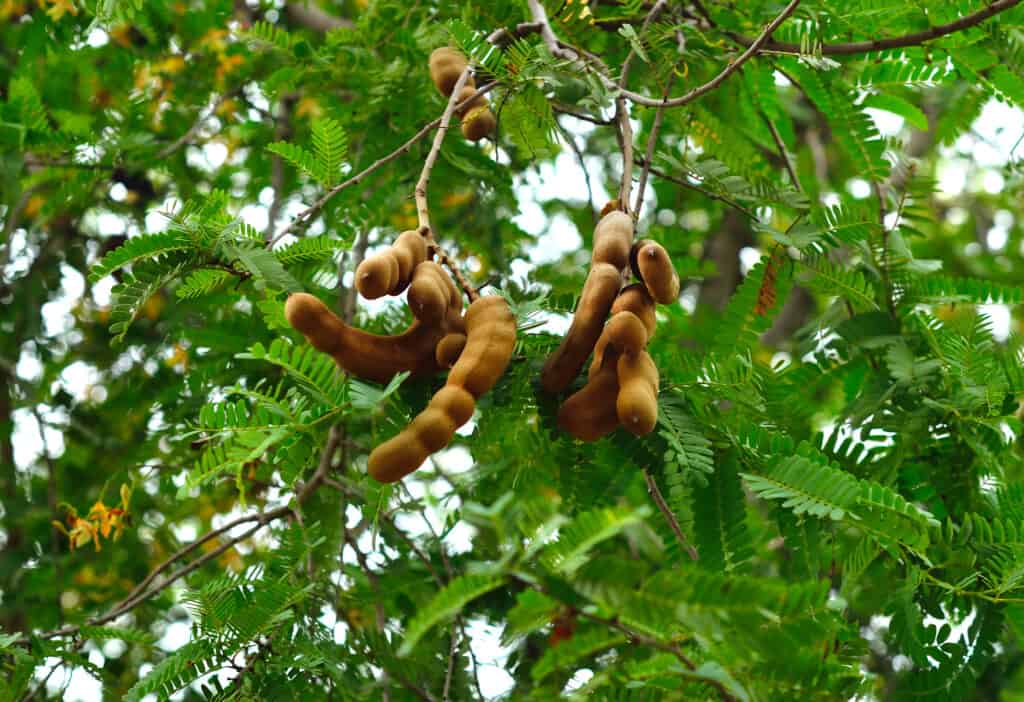
With tasty fruit, serving as fine decor, and wood that is used in carpentry, tamarind trees serve many uses.
©iStock.com/mypuy
This tree is commonly grown in tropical and subtropical areas for its tasty fruit, whose pulp is frequently utilized in traditional meals, drinks, and remedies. The plant is a common element in the food of those areas and is particularly well-liked in the Indian subcontinent, Central America, and Mexico.
The tamarind tree is also grown for decorative purposes, as well as carpentry uses with the wood from the tree. The tree has alternate, pinnately complex leaves with lobes that are about 0.75 inches long and reaches a height of about 80 feet.
The little clusters of yellow blooms are produced. One to twelve big, flat seeds are implanted in the fruit, which is a plump legume that is between three and nine inches long and does not break open.
9. Kapok Tree
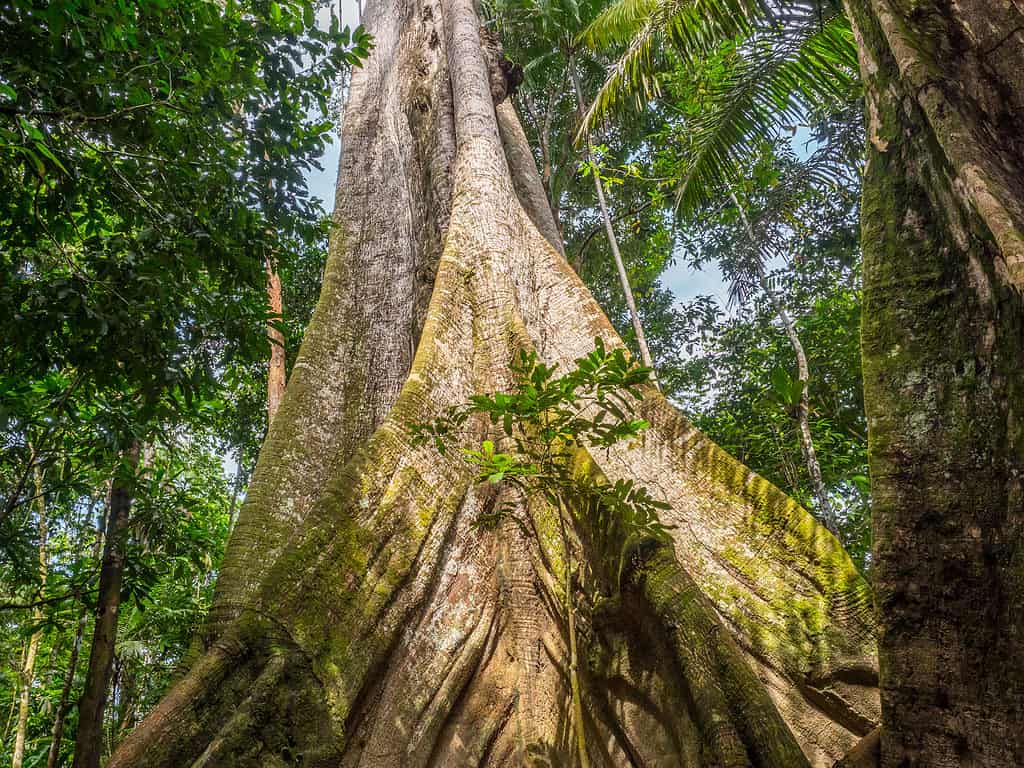
With the ability to grow up to 200 feet, the kapok tree is massive, even when compared to other trees in rainforests.
©Nowaczyk/Shutterstock.com
The kapok tree, a behemoth in the rainforests, may grow up to 200 feet tall and can occasionally gain up to 13 feet each year. This kapok, or ceiba tree, looms over other tropical plants because of its extraordinary height.
The kapok tree has a threatening aspect due to certain of its types’ spines or conical thorns. The trunk can develop to a diameter of nine or ten feet. Amphibians, birds, and succulents are just a few of the many species that may be found living in the crevices and crevices of this enormous plant.
The kapok tree sheds all of its leaves during the dry period since it is deciduous. This tree is excellent at dispersing its seeds; at any given moment, it can produce 500–4,000 fruits, each of which contains 200 seeds. Silky fibers released when the fruit busts open dispersed the numerous seeds throughout the woodland.
10. Papaya Tree

All tropical regions grow papaya trees.
©iStock.com/Elisa Irmalia
Papaya, Carica papaya, often known as papaw or pawpaw, is a big plant in the Caricaceae family that produces a succulent fruit. The papaya may be a hybrid of two or more Carica species that are native to Mexico and Central America, despite the fact that its origins are found in Vietnam.
Currently, it is grown in all tropical regions as well as the warmest regions of the subtropics. The papaya fruit has a pleasant musky flavor that is full of flavor and more strong in some types and climates than in others. It is a well-liked fruit for breakfast in many nations.
Although the papaya plant can grow up to 26 feet tall and has a palm-like trunk, it is not as rough as the name might suggest. Heavily lobed leaves, sometimes measuring two feet across, are carried on two-foot-long hollow petioles, also known as leaf stalks.
Although the species is typically dioecious, with male and female flowers growing on distinct plants, there are known non-binary varieties, and there are many anomalies in the arrangement of the sexes.
11. Traveller’s Palm

The traveler’s palm tree is one of the most recognizable palm trees in the world.
©ANECEPTIUS BAMBANG SUTOPO/Shutterstock.com
One of the most iconic palm trees on the planet is the traveler’s palm tree, scientific name Ravenala madagascariensis, which is known for its beautiful fronds that come in a variety of colors, including orange, yellow, and green. It can adjust to a variety of soil types. In the yard or beside the pool, a Travelers Palm Tree can make a lovely shaded spot.
As the palm ages, a short, green trunk with distinct leaf scar bands and a diameter of around one foot emerge. The Travelers Palm has around 30-35 enormous, fan-shaped leaves that are 10 feet long and are held upright by long petioles. The tree has the appearance of a hand fan due to its neatly clustered leaves that mimic banana leaves.
The leaves might look like feathers when they are shredded by strong gusts. The color of leaf stems changes, ranging from orange at the bottom to yellow in the center, and finally to bright green near the end.
In times of drought, leaf stems may store a significant amount of rainwater which is able to serve as a temporary water source. The Travelers Palm got its name since there are many tales of travelers seeking this specific tree in hopes of finding drinkable water.
12. Persimmon Tree

With the lovely fruit that lingers on the tree well into fall, persimmon trees are particularly beautiful.
©iStock.com/cbglp2
Asian natural plant known as the Japanese or Oriental Persimmon has been cultivated for many years. The tree can reach 25 feet in height and width as a single- or multi-trunked deciduous tree. It is a beautiful decorative tree with branches and hanging shiny green leaves that provide the tree with a flowy, somewhat tropical appearance.
When the leaves turn a stunning shade of yellow, orange, or red in autumn, they make a lovely spectacle. Persimmon plant leaves, whether they are fresh or dried, can also be used to make tea. The lovely orange or crimson fruit lingers for a long time on the tree in the fall, adding to its decorative appeal.
Persimmons are highly well-liked by hunters as a way to draw in wildlife during the Fall ripening season. Fruits can be divided into astringent and non-astringent groups. When mature, the non-astringent is just as crisp as an apple.
13. Casuarina Tree
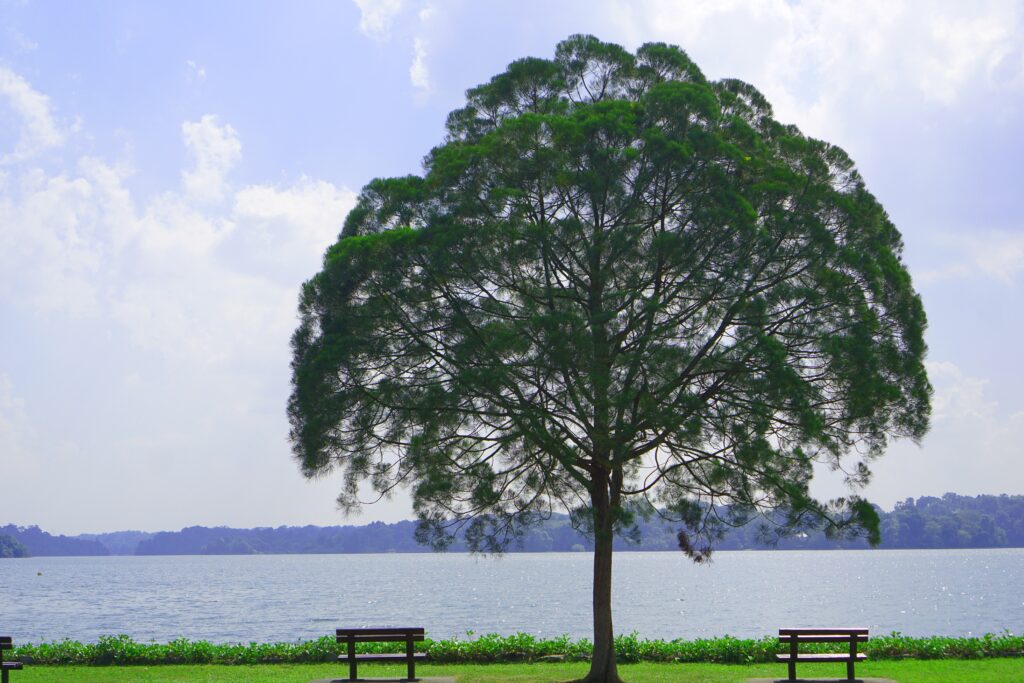
Able to grow up to 10 feet in their first year, and reaching maximum heights between 60 and 100 feet, casuarina trees can grow quickly.
©Kannanat J/Shutterstock.com
Casuarina trees, often known as Australian pines, first appeared in the United States in the early 1800s. Although helpful as windbreaks and kindling, casuarina trees have developed a bad reputation in several places, especially in Florida.
They can also be found in California and Hawaii, among other states. In their first year, they can reach a height of up to 10 feet. Casuarina trees can grow quickly and can grow to a height of 60 to 100 feet. Their medium-green, delicate needles are very long and complex.
In the late summer and early fall, they produce small, seed-filled cones and little, yellow, red, or brown flowers. Casuarina trees are most frequently found in coastal regions, but they are also prevalent inland in temperate conditions.
The tree can thrive where many trees can’t because of its tolerance to salt. Almost primarily found on beaches, the Casuarina equisetifolia variety grows there. Casuarina cunninghamiana and Casuarina glauca are seen growing along roadways in warm interior places, as well as in coastal areas.
14. Dragon Fruit Tree
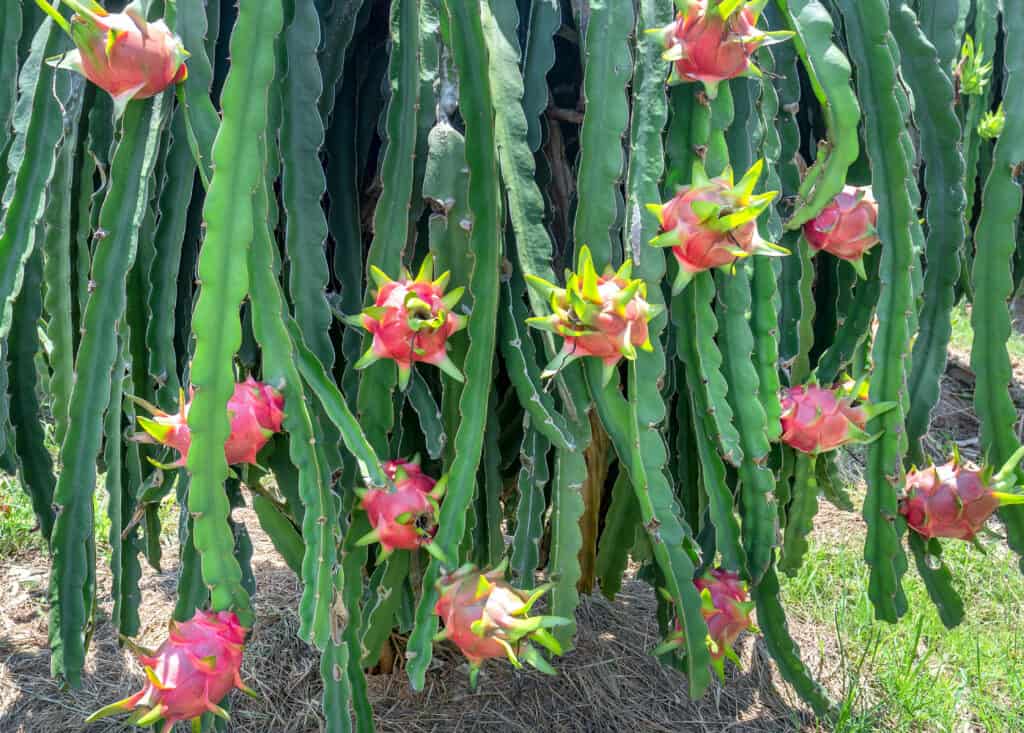
With high levels of vitamin C and carotene, dragon fruits are a nutritious food.
©iStock.com/HuyThoai
Each huge, fragrant white blossom blooms from July through October for just one night before withering by daylight. The “dragon” in the name relates to the creature’s scaly skin and sharp spikes, which would make someone hesitant to eat it.
But of course, you can enjoy this fruit. It’s slightly sweet, with small, crunchy black seeds reminiscent of kiwis, and is very healthy. The yellow dragonfruit is much sweeter than the pink and purple varieties. High quantities of vitamin C and the anti-cancer compound carotene are present in this tropical fruit.
As a true tropical plant, dragon fruit requires temperatures of around 40 degrees Fahrenheit, with an ideal range of 60 to 80 degrees. Dragon fruit may be able to survive outside all year in USDA zones nine through 11.
But, if you reside outside of those temperate zones and are interested in growing one of these gorgeous trees, it’s ideal to use a large container so that you can bring the plant and pot indoors when the weather becomes chilly.
15. Cannonball Tree

The fruit of a cannonball tree mimics a rusted cannonball.
©Pollapat Thunbenjang/Shutterstock.com
The cannonball tree (Couroupita guianensis), a towering, soft-wooded tree of the family Lecythidaceae, is well-known for its huge, round woody fruit, which mimics a rusted cannonball.
The leaf margins are flat or coarsely serrated and have an oval, oblong, or wide lance form. The eye-catching blooms have concave petals that are about two inches long and are produced in racemes that are two to three feet long.
They have an exterior color of yellow or red and an interior color of crimson or lilac. The fruit’s interior is pulpy and packed with seeds, and it can go up to eight inches in diameter. In the area, the hard shell is utilized to create kitchenware.
Summary of 15 Trees Native to Vietnam
| Tree | Unique Characteristic | |
|---|---|---|
| 1 | Flame Tree | Red and orange fern-like folliage |
| 2 | Jackfruit Tree | Tropical evergreen with large, round fruit |
| 3 | Copperpod Tree | This invasive tree has coppery blooms |
| 4 | Teak Tree | Striking, tall trees that are members of the mint family – known for their strong, beautiful wood |
| 5 | Coconut Palm | Tall tropical palms that produce delicious, healthy fruit |
| 6 | Tropical Almond | Deciduous tree with enormous leaves on wide-reaching horizontal branches |
| 7 | Indian Milkwood Pine | Lovely shaped tree with regular branching and rounded, velvety, dark green leaves that form appealing, fragrant whorls |
| 8 | Tamarind Tree | A decorative tree with delicious fruit and beautiful wood |
| 9 | Kapok Tree | This massive tree can grow to 200 feet |
| 10 | Papaya Tree | A tall fruit tree with a palm trunk and fan-like leaves |
| 11 | Traveller’s Palm | Short trunks with large, fan-shaped leaves |
| 12 | Persimmon Tree | A beautiful decorative tree with shiny, hanging leaves and round, orange fruit |
| 13 | Casuarina Tree | A kind of pine tree with a rounded shape |
| 14 | Dragon Fruit Tree | A unique tree with long, hanging leaves and large, prickly, pink fruit |
| 15 | Cannonball Tree | A towering, soft-wooded tree with large, cannonball-like fruit |
The photo featured at the top of this post is © aimpol buranet/Shutterstock.com
Thank you for reading! Have some feedback for us? Contact the AZ Animals editorial team.






